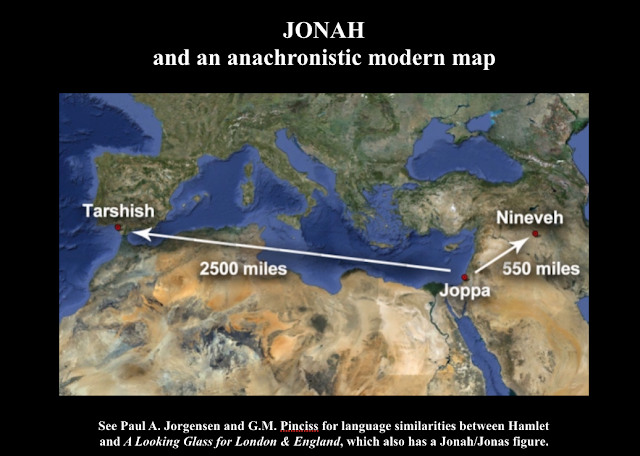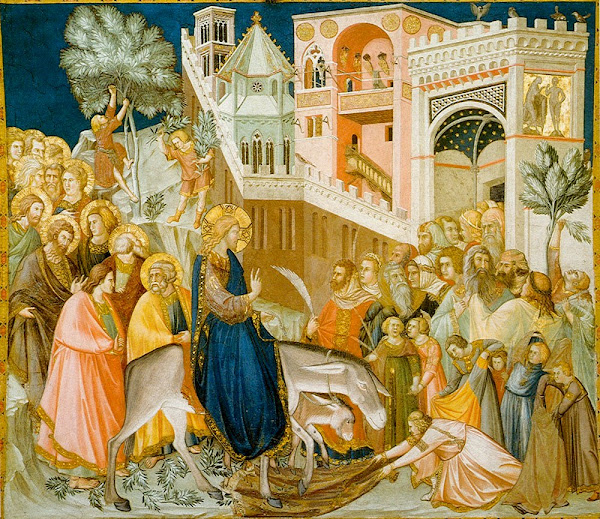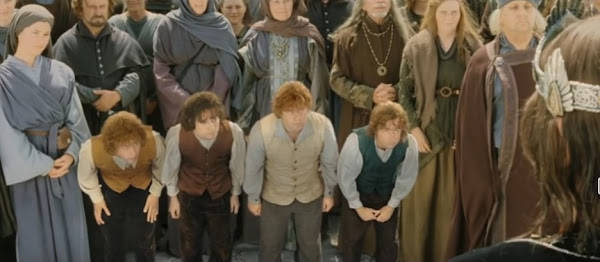INDEX: Hamlet and Holy Week Bible Allusions
I’ve compiled this post from my previous posts about Holy Week allusions and plot echoes in Hamlet.
(Updated, 2025.)
Some of these are clearly allusions in a traditional sense;
Others are plot echoes, as with the Jonah echoes in Hamlet’s sea voyage.
Others involve how the play appeals to what the national religion(s) conditioned playgoers to think and feel about certain elements, such as “They know not what they do,” or Gertrude’s “Veronica complex,” wiping the face of Hamlet…
This blog post contains links to the following posts. In summary:
~~~
PALM SUNDAY:
Hamlet's Palm Sunday Allusion & Cognitive Dissonance: "preaching to stones, Would make them capable."
[Image: Pietro Lorenzetti (1280–1348), Untitled, known as Christ's entry into Jerusalem. Fresco, Basilica of San Francesco d'Assisi. Public domain. Via Wikimedia.]
HAMLET: On him, on him! Look you how pale he glares.
His form and cause conjoined, preaching to stones,
Would make them capable. (3.4.142-4)
- From Palm Sunday reading (Geneva trans.), Luke 19:40:
"I tell you, that if these should hold their peace, the stones would cry."
- But note the cognitive dissonance this allusion creates: The apparition that claims to be the ghost of Hamlet's father in purgatory is not the same as Jesus on Palm Sunday...
~~~
MAUNDY THURSDAY (or "Holy Thursday"):
Hamlet, Footwashing, Maundy Thursday, Hobbits, and Revelation
[Image: Screen capture from YouTube clip of The Lord of the Rings: The Return of the King (2003), directed by Peter Jackson, Warner Bros. based on the book by J.R.R. Tolkien. Fair use.]
Henry VIII and his children reenacted Jesus washing the disciples feet (John 13:1–17) by washing the feet of the poor, trading places by acting as servant.
- When Horatio in 1.2.165-9 calls Hamlet "your lordship" and "lord," presenting himself as "your poor servant ever," Hamlet replies, "Sir, my good friend. I’ll change that name with you."
This oment in Hamlet 1.2 also echoes a passage from Revelation, as noted by Linda Kay Hoff.
~~~
EUCHARIST ALLUSIONS:
Eucharistic Allusions in Hamlet
[Image: David Tennant and Patrick Stewart in the Royal Shakespeare Company production of Hamlet directed by Gregory Doran, 2008. Image from RSC (here), cropped. Fair use.]
Scholars have noticed many allusions in Hamlet to Eucharist and the mass (and argue whether they are more Protestant or Catholic).
A few:
1.5.84: “Unhous'led,” not having received Eucharist in the Last Rites.
1.5.98: "Remember me.” (Compare, Jesus at the Last Supper: “Do this in memory of me.”)
2.1.56-8 and 3.2.408: Polonius: “by the Mass” (mildly blasphemous).
2.2.555: Hamlet: “God’s bodykins, man!” OED: "God's dear body," or “Christ’s little bodies,” Eucharist, or pin, or dagger, or the nails used in the crucifixion.
4.3.20-35: Hamlet: Polonius is “at supper,” “Not where he eats, but where he is eaten.”
“...how a king may go a progress through the guts of a beggar.” (Ironic Eucharistic implications)
5.1.184-7: The gravedigger tells of how Yorick once poured a flagon of Rhenish wine on his head.
With this tale of poured wine, Hamlet recognizes the connection of the gravedigger to his beloved Yorick,
as the disciples on the road to Emmaus recognize Jesus in the breaking of the bread.
5.2.240-1: Hamlet apologizes to Laertes and asks for pardon before the “Black Mass” of Claudius with his poison cup.
In the English church service, a general confession always precedes the communion service.
5.2.291 Claudius says he will throw a “union” or (later) pearl (5.2.306) into the cup of wine he called a "chalice" in 4.7.183.
The image of a white pearl held over the cup recalls the white host or wafer of bread held over the chalice.
~~~
GOOD FRIDAY:
Good Friday/Christ’s Passion Allusions in Hamlet
The betrayal, torture, crucifixion, and death of Jesus is retold in the Bible (Mark 14-15, Matthew 26-27, Luke 22-23, John 18-19).
Shakespeare’s Hamlet echoes a number of details from these stories and from larger Christian tradition. (See also Shaheen.)
[Image: David Tennant in 2008 RSC production of Hamlet, directed by Gregory Doran. Via BBC. Fair use.]
Examples:
1.1.125-137: Horatio describes the dead rising and signs in the heavens upon the death of Caesar, resembling description of events at Jesus' death in Matthew 27:53 and Luke 23:44-45.
1.1.162 and 163-4: “it started like a guilty thing / Upon a fearful summons.” This echoes the cock crowing at Peter's denial of Christ.
2.2.555: “God’s bodykins": Oxford English Dictionary: "God's dear body" or Eucharist. Or according to some, this may refer to the nails traditionally believed to have been used in the crucifixion.
2.2.603 and 5.1.290: Hamlet: “‘S'wounds!” Short for “By Christ’s wounds!”
5.1 "Whose skull?" (memento mori and Golgotha)
5.2.321: Gertrude offers to wipe the sweaty brow of Hamlet who is dueling with Laertes. David Kaula (1984) connects this to Veronica wiping the face of Jesus on the way to the crucifixion. (Loosely related to the gospel mention of Jesus greeting the women on the way to crucifixion, yet Veronica is not strictly gospel but legend/apocryphal.)
~~~
GOOD FRIDAY & CAIN IN GERTRUDE'S CLOSET
Compare:
Hamlet 3.4.31-32, after Hamlet kills Polonius unseen:
Queen: O me, WHAT HAST THOU DONE? *
Hamlet: Nay, I KNOW NOT. Is it the King? * [1]
Genesis 4:9-10, Geneva trans.:
Then the Lord said unto Cain, Where is Abel thy brother?
Who answered, I cannot tell. Am I my brother’s keeper?
Again he said, WHAT HAST THOU DONE? *
the voice of thy brother’s blood crieth unto me, from the earth.
Luke 23:34, Geneva, Jesus from the cross:
Then said Jesus, Father, forgive them:
for THEY KNOW NOT what they do. *
(* Emphasis mine)
- Queen Gertrude echoes God to Cain: What hast thou done?
- Hamlet echoes Jesus from the cross: I know not (what I've done).
AT LEAST TWO IMPLICATIONS:
1. By killing a human being, Hamlet has sinned, like Cain killing his brother.
2. By stabbing the person hidden behind the arras, blind to who he was stabbing, Hamlet fits what Jesus says from the cross: They know not what they do.
WHY HAS THIS BEEN MISSED by previous scholars of Shakespeare and the Bible such as
C. Wordsworth (1864) [2],
T. Carter (1905) [3],
R. Noble (1940) [4],
P. Milward (1987) [5] and
N. Shaheen (1999) [6]?
The Genesis allusion casts Hamlet as a Cain figure (as Claudius thinks himself),
and Polonius like Abel in this analogy;
and the Luke passion narrative allusion casts Hamlet as a crucifier.
All of these scholars would have been familiar with the Bible passages, and the Geneva translations.
But casting Hamlet as a Cain and crucifier may have been too harsh (too much cognitive dissonance, to have Hamlet as a second Cain figure in a story where Claudius is already offered as a Cain figure?).
Casting a meddling Polonius as innocent brother and Abel figure may have been too kind, at least in their minds - ?
https://pauladrianfried.blogspot.com/2025/04/cain-and-jesus-in-gertrudes-closet.html
~~~
"THEY KNOW NOT WHAT THEY DO": Hamlet as Crucifier in Gertrude's Closet
If we are uncomfortable (as I think we should be) with the idea of Hamlet as a simple Christ figure, we might consider how the words of Jesus from the cross, as told in Luke 23:34:
"Father, forgive them; they know not what they do."
Immediately after Hamlet stabs the unseen Polonius in Gertrude's closet behind an arras, Gertrude asks him what he has done, and Hamlet replies,
"I know not. Is it the King?"
3.4.2405-2407
A Hamlet who kills without knowing what he is doing connects him to the crucifiers in Luke, who the gospels have Jesus identify as not knowing what they do.
https://pauladrianfried.blogspot.com/2020/11/know-not-what-they-do-crucifier.html
~~~
HOLY SATURDAY:
HAMLET'S SEA-VOYAGE, CHRIST IN THE TOMB, & "THE SIGN OF JONAH":
Hamlet's Sea-voyage, Christ in the Tomb, and "the Sign of Jonah"
I have posted previously about the sea-voyage of Hamlet as resembling that of the prophet Jonah.

But the connection of Hamlet to Jonah also connects Hamlet to the Christian tradition of viewing Jesus in the tomb as being like Jonah in the belly of the fish. Jonah was thought to be a "type" of Christ (typology).
- Jonah later emerges alive, as Hamlet survives his sea voyage and capture by pirates.
- This connects Hamlet's sea voyage not only to Jonah, but also to Christ in the tomb, and to the resurrection.
- This is not to say Hamlet=Christ, but on the other hand, every repentant Christian sinner is called by baptism to be an image of Christ.
- The descent of Hamlet into temptation, madness, and sin, make possible more pity and catharsis for those who witness the play.
~~~~
Holy Saturday and the Harrowing of Hell in Shakespeare and Christianity:
https://pauladrianfried.blogspot.com/2024/03/holy-saturday-and-harrowing-of-hell-in.html
~~~~
It is one thing to identify the allusions and plot echoes: It is an altogether different project to consider what they mean, whether they are serious or ironic, or some of each...
~~~~~~~~~~~~~~~~~~~~~~~~~~~~~~~~~~~~~~
Thanks for reading!
~~~~~~~~~~~~~~~~~~~~~~~~~~~~~~~~~~~~~~
~~~~~~~~~~~~~~~~~~~~~~~~~~~~~~~
~~~~~~~~~~~~~~~~~~~~~~~~~~~~~~~
YOU CAN SUPPORT ME on a one-time "tip" basis on Ko-Fi:
https://ko-fi.com/pauladrianfried
IF YOU WOULD PREFER to support me on a REGULAR basis,
you may do so on Ko-Fi, or here on Patreon:
https://patreon.com/PaulAdrianFried
~~~~~~~~~~~~~~~~~~~~~~~~~~~~~~~
~~~~~~~~~~~~~~~~~~~~~~~~~~~~~~~
Disclaimer: If and when I quote or paraphrase bible passages or mention religion in many of my blog posts, I do not intend to promote any religion over another, nor am I attempting to promote religious belief in general; only to explore how the Bible and religion influenced Shakespeare, his plays, and his age.
~~~~~~~~~~~~~~~~~~~~~~~~~~~~~~~~~~~~~~
~~~~~~~~~~~~~~~~~~~~~~~~~~~~~~~~~~~~~~
Thanks for reading!
~~~~~~~~~~~~~~~~~~~~~~~~~~~~~~~~~~~~~~
~~~~~~~~~~~~~~~~~~~~~~~~~~~~~~~~~~~~~~
My current project is a book tentatively titled Hamlet’s Bible, about biblical allusions and plot echoes in Hamlet.
Below is a link to a list of some of my top posts (“greatest hits”), including a description of my book project (last item on the list):
https://pauladrianfried.blogspot.com/2019/12/top-20-hamlet-bible-posts.html
I post every week, so please visit as often as you like and consider FOLLOWING.
To find the FOLLOW button, go to the home page: https://pauladrianfried.blogspot.com/
see the = drop-down menu with three lines in the upper left.
From there you can click FOLLOW and see options.







Comments
Post a Comment